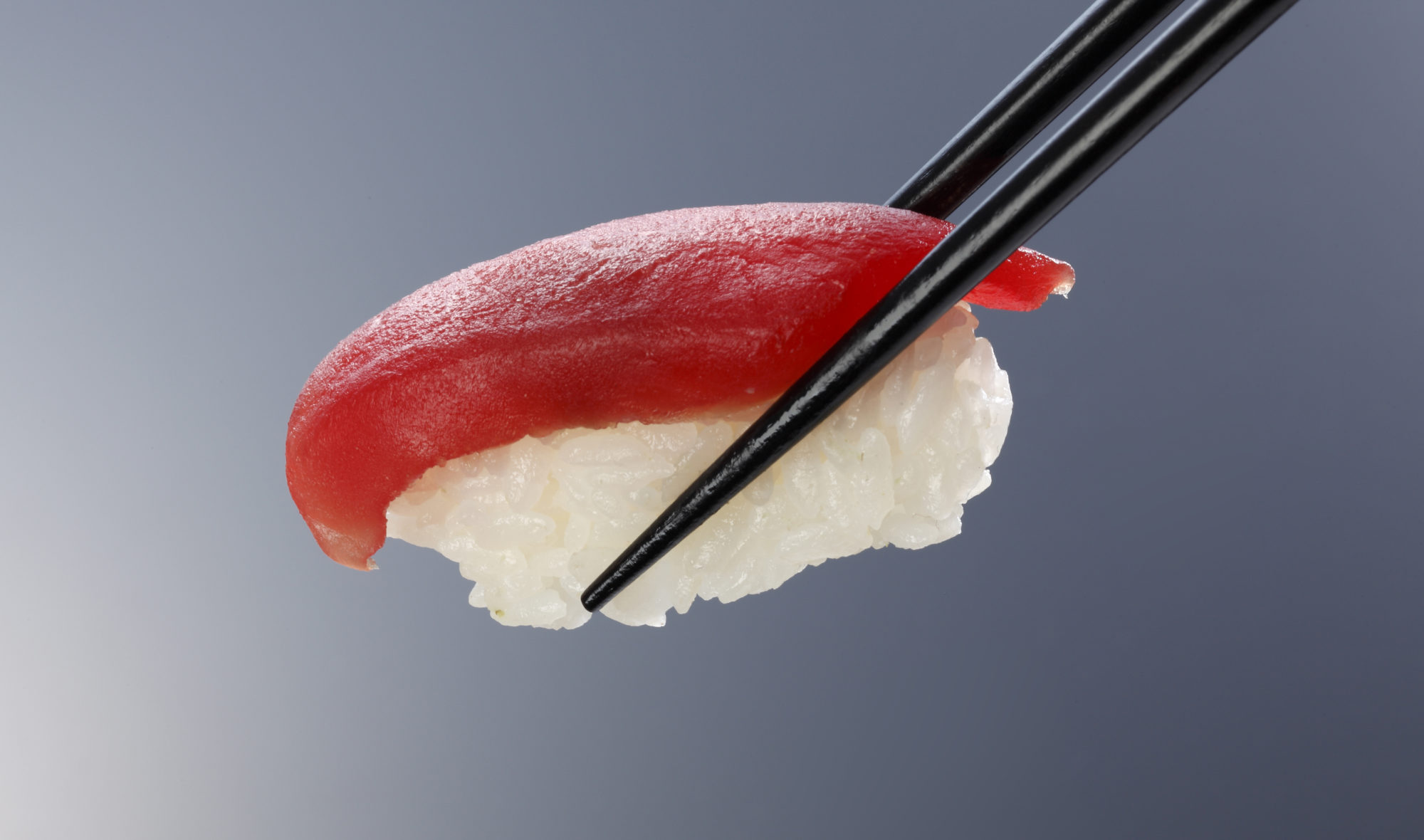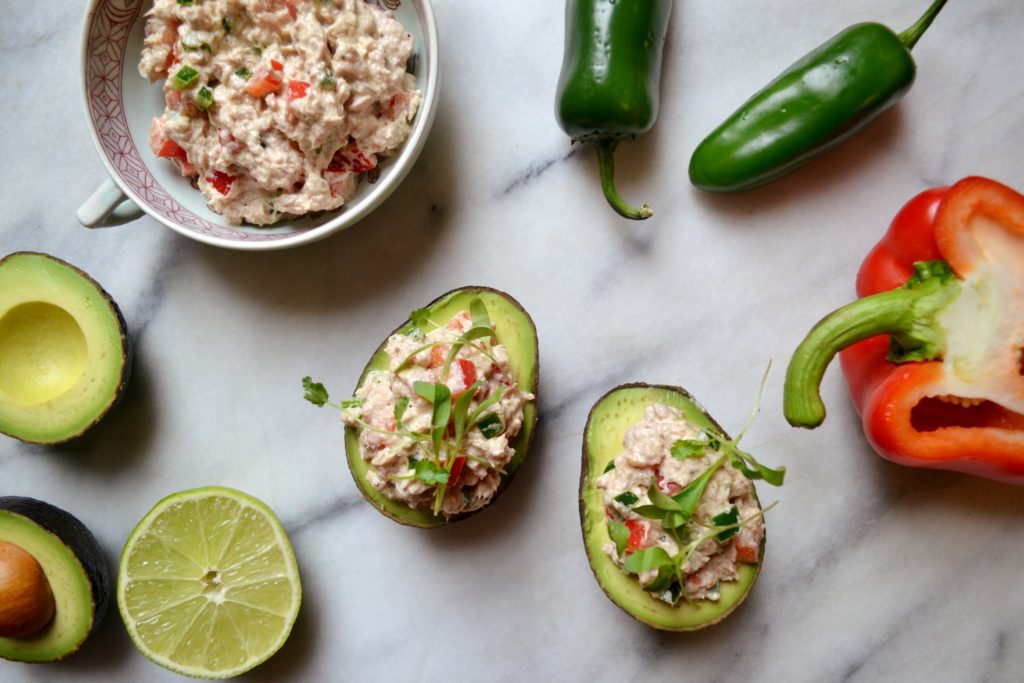
🎁 Holiday Special: SAVE 52% on the Nutrition Coach Starter Package. Limited number remaining.

🎁 Holiday Special: SAVE 52% on the Nutrition Coach Starter Package. Limited # left.

Tuna is a big fish with big consumer demand. Tuna is America’s second most popular seafood, after shrimp. This popularity continues despite concerns about the environmental sustainability of the species, as well as its mercury content. If you are conscious of these concerns, skipjack tuna is probably your best choice. This species is relatively low in mercury and still populates the ocean in good numbers compared to other species of tuna. Although tuna may be purchased fresh, it is found most frequently in a can, where it may be sold as a solid loin, in chunks, or in flakes, and may be packed in either water, oil, flavored sauces, or broths. Raw or lightly cooked tuna has a mild oceanic flavor and a tender and luxurious mouthfeel. Canned tuna is rather dry and has a strong fish smell, but is ideal for turning into sandwiches.
Tuna comes in a small can, but it’s a big fish.
Tuna is a saltwater fish that belongs to the Thunnini tribe, which includes subgroups like yellowfin, bluefin, albacore, skipjack, tongol, and bigeye. Some tuna species measure under two feet long and weigh less than four pounds, whereas others are more intimidating; a large bluefin can measure up to 15 feet long and can weigh up to 2000 pounds.
Tuna is also a big industry. In North America, a large tuna can easily be worth $20,000 or more. In Japan, tuna fishing can be even more lucrative. Records have been set with a mid-size bluefin selling for over $1.5 million USD.
However, as a result of commercial demand and overfishing, several species of tuna are threatened for extinction. In particular, bluefin tuna are in critical condition. Albacore, skipjack, and yellowfin still populate oceans in better numbers and are therefore better choices for environmentally conscious consumers.
Due to concerns about mercury content, the Environmental Protection Agency suggests limiting consumption to one 6 oz can of tuna a week for individuals weighing under 110 lbs, and two cans for individuals who weigh more. Larger species, such as bluefin and albacore, have higher positions in the food chain and accumulate more heavy metals from their diet. If mercury is a concern, consumption of these species should be minimized.
Despite the aforementioned concerns, tuna is America’s fish sweetheart. After shrimp, it is the second most popular seafood. The vast majority of tuna is sold in cans, and made into sandwiches.
Tuna is a very large fish, and therefore, most consumers will never see one in its entirety, unless they frequent specialty fish markets.
Mostly, tuna is sold in cans or portioned into steaks and fillets, sold fresh or frozen.
Fresh tuna has a deep, reddish brown color and a firm, meaty texture. Raw, as it is sometimes found in sushi and sashimi, it has a delicate, slightly sweet flavor and a smooth, pleasantly oily texture. When cooked, the oceanic flavors become more pronounced and the texture toughens. Most culinary experts prefer tuna served lightly seared rather than cooked through.
Canned tuna can be packed in water, oil, or in sauces or broths, all of which will influence flavor. Canned tuna has a slightly tough, dry texture and ranges in color from blush to dusty rose, depending on the species. Canned tuna has a pronounced fishy flavor; opening a can will provoke all the neighborhood cats to come running.
One (drained) can of light tuna, packed in water (about 165g) has 142 calories, 32.1g protein, 1.6g of fat, and no carbohydrates, fiber, or sugar. Tuna is an excellent source of vitamin D and phosphorus, and a good source of iron.
The Environmental Protection Agency suggests limiting consumption to one 6 oz can of tuna a week for individuals weighing under 110 lbs, and two cans for individuals who weigh more.
Tuna is most widely available in a can, where it can be found in most stores that sell food.
When canned, or less commonly, jarred, tuna can come in solid, chunk or flaked varieties, which are further categorized as either “white” or “light”. Tuna may be packed in either water, oil, brine, broth, or flavored sauces.
Solid tuna is usually more expensive and means the tuna was packaged as a whole loin. Chunk tuna is made from broken pieces of the loin, and flaked tuna are the leftover pieces, which tend to be very small fragments of the loin.
The “white” or “light” descriptor refers not only to the species of tuna, but also correlates to the mercury content. Generally, white tuna refers to yellowfin and albacore tuna, and light tuna refers to skipjack and tongol. Light tuna typically has lower levels of mercury than white tuna.
Most tuna is packed in water, but you may also find it packed in oil or other flavored mediums. As with all packaged foods, read the ingredients. Skip over products that contain high amounts of sugar, poor quality oils, or unpronounceable ingredients.
Fresh or frozen tuna can be found at larger grocery stores and fish markets. Shop at stores you trust that are known to have fresh products.
When buying fresh tuna, look for cuts that look moist (but not wet) and almost translucent looking with a deep color. Raw tuna should have a fresh seaside smell as opposed to a strong fishy smell, which may be a sign that it has gone bad. Other signs that tuna is going bad include dullness or browning (a sign of oxidation) or “gapping”, which occurs when the muscle starts to separate into flakes, creating gaps in the meat.
Unless it remains in a sealed can (in which case it will have a long shelf-life; refer to the label’s expiration date), tuna should be kept refrigerated or frozen.
Raw fish is best prepared the day of purchase, although it will keep for about 24 hours in the fridge. If you know the tuna you have purchased was not previously frozen and then thawed, you can freeze it. Simply wrap it securely in plastic and freeze for up to three months. If however, you purchase tuna that was frozen and thawed, it’s best not to refreeze it.
Once cooked, tuna will keep in the fridge for three to four days, or frozen in an airtight container for up to three months.
A tuna salad prepared from canned tuna with mayonnaise should be kept in a sealed container and will last in the fridge for three to five days.
Canned tuna is ready to eat straight from the can, although a little seasoning may be required to make it taste more interesting if it was packed in water.
Fresh tuna is best when cooked lightly, so that the outside has a nice sear and the inside is still tender. Here’s how to do that:
First, using a clean piece of paper towel, pat the outside of your tuna dry. Excess moisture on the outside will prevent the lovely caramelization that is characteristic of a good sear.
Then, add your choice of oil or butter to a pan and heat over medium-high heat. Allow to heat until oil / butter is shimmering.
Place your tuna cuts onto the pan, and season with salt. The meat should begin to sizzle as soon as it meets the pan. Cook each side of the tuna for 1-2 minutes. Try not to lift or shuffle around the pieces until this time has elapsed, as this will prevent proper searing. If your cut of tuna is especially thick (over an inch), you may want to increase this time to 2-3 minutes on each side.
Once cooked, the tuna is ready to serve. Top with additional seasoning if desired.

A humble ingredient that nearly everyone has in their cupboard - canned tuna - gets a fresh twist with colorful, crunchy “confetti” pieces of jalapeno and bell pepper. Topped over ripe avocado boats, this makes a healthy lunch that’s delicious and simple to put together.
Prep Time: 20 minutes Cook Time: 0 minutes Yield: 2-4 servings
In a bowl, mix together the tuna, greek yogurt, lime juice, salt, and pepper. Fold in chopped peppers.
Divide the tuna mixture into four, and top over avocado halves.
Sprinkle with freshly chopped cilantro, and serve.
Precision Nutrition’s Encyclopedia of Food expands every single month as we highlight new foods and showcase beautiful food photography. If you’d like to stay up to date, simply click this link. From there, we’ll send you a FREE copy of our recipe book. We’ll also let you know when new and delicious foods are added to the site.
Tuna is a big fish with big consumer demand. Tuna is America’s second most popular seafood, after shrimp. This popularity continues despite concerns about the environmental sustainability of the species, as well as its mercury content. If you are conscious of these concerns, skipjack tuna is probably your best choice. This species is relatively low in mercury and still populates the ocean in good numbers compared to other species of tuna. Although tuna may be purchased fresh, it is found most frequently in a can, where it may be sold as a solid loin, in chunks, or in flakes, and may be packed in either water, oil, flavored sauces, or broths. Raw or lightly cooked tuna has a mild oceanic flavor and a tender and luxurious mouthfeel. Canned tuna is rather dry and has a strong fish smell, but is ideal for turning into sandwiches.